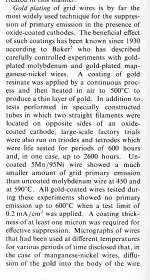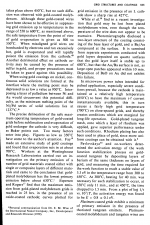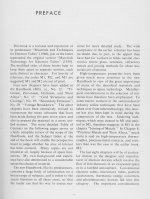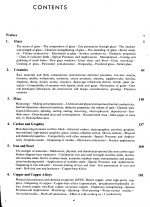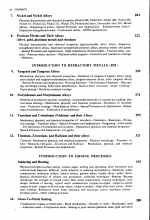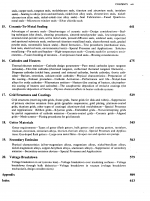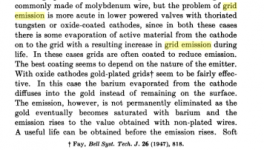I have a bad habit of obsessively buying and reading books. My apologies for infecting anyone. 😀
Preface to the 1967 edition:
and Contents
and Contents
Attachments
Last edited:
Gold
Electronegativity (Pauling scale):7 2.4
Electropositivity (Pauling scale): 1.6
Electron Affinity:8 2.30863 eV
Oxidation States: +3,1
Work Function:9 5.32 eV = 8.52264E-19 J
Thermal Conductivity: 317 (W/m)/K, 27°C
Nickel
Electronegativity (Pauling scale):6 1.91
Electropositivity (Pauling scale): 2.09
Electron Affinity:7 1.156 eV
Oxidation States: +2,3
Work Function:8 5.15 eV = 8.2503E-19 J
Thermal Conductivity: 90.7 (W/m)/K, 27°C
The above data comes from this site. SILVER (Ag) • Element47 • Physical Properties/Chemical Properties • Description • Uses/Function • Isotopes • Thermochemistry • Reactions • Electron Configuration and Bonding
Change the last two letters for a different element ie. AG, Au, or Ni
DT
Very good reference, thanks.
I should change a bit my calculations, but they are a rough approximation, only intended to clarify the electron affinity issue.
Work function measurement is very hard, no surprise different values in a lot of papers too.
I did it once for the filamentar cathode of a 5R4GY, maybe somewhere I have the results.
You guys are making things difficult
You guys are making things difficult.
Just spent $10 for another book.
Sy this is another chapter in the story of too many books.
There are two book titles we are speaking of here, both by Kohl.
“Materials technology for electron tubes” this is the first title
“Handbook of Materials and Techniques for Vacuum Devices” this is the later title.
DT
You guys are making things difficult.
Just spent $10 for another book.
Sy this is another chapter in the story of too many books.
There are two book titles we are speaking of here, both by Kohl.
“Materials technology for electron tubes” this is the first title
“Handbook of Materials and Techniques for Vacuum Devices” this is the later title.
DT
There are two book titles we are speaking of here, both by Kohl.
Hey, it is forbidden to talk about politics 😀😀
Back on topic....
Guys, can we stop the endless woffle about work function?
If yiou plug the relevant constants into the Richardson-Dushman equation, including grid temperature in an oxide cathode tune (1000 K), the work function of various metals, Boltzmann's constant, A= 120 A/cm^2, you find that:-
a) the emision for various metals that could be used for grids varies over about an order of magnitude;
-but-
b) the emission is not even nanoamps.
Thus, unless oxide material migrates from the cathode to the grid (which it does by vaporisation) there cannot be a problem. Measures to reduce grid emision are thus directed to nuetralising the migrated oxide, or preventing it from landing on the grid.
Guys, can we stop the endless woffle about work function?
If yiou plug the relevant constants into the Richardson-Dushman equation, including grid temperature in an oxide cathode tune (1000 K), the work function of various metals, Boltzmann's constant, A= 120 A/cm^2, you find that:-
a) the emision for various metals that could be used for grids varies over about an order of magnitude;
-but-
b) the emission is not even nanoamps.
Thus, unless oxide material migrates from the cathode to the grid (which it does by vaporisation) there cannot be a problem. Measures to reduce grid emision are thus directed to nuetralising the migrated oxide, or preventing it from landing on the grid.
Fascinating discussion, thanks guys!
Tim
I am enjoying this dialog that has gone down the rabbit hole in the pursuit of work function. Yes this is a rabbit hole conversation, who in their right mind has a clue about work function in the first place?
Hot enough gold will vaporize and poison the work function of the barium oxide coated cathode. The converse is less likely, barium oxide poisoning the gold coated grid. A molybdenum grid may not fare so well.
Being correct about one thing inside that envelope does not end the conversation. There is so much more to understand.
Is work function constant, does it follow a normal distribution and have a standard deviation? Barium oxide flickers.
How is a gold grid different?
DT
Last edited:
I'll answer the last part first.
Yes, oxide cathodes exhibit the phenomena known as "flicker noise" aka 1/f noise, a phenomena that does not occur in pure tungsten cathodes and thoriated tungsten cathodes.
Just why oxide cathodes make flicker noise has never beed completely understtod, theough all tube manufactuers learnt how to minimise it. It seems to have something to do with the fact that barium oxide and strongtium oxide, calcium oxide, and all other oxides that have been tried are electrical insulators. All oxide cathodes are micro-porous. They consiats of micoscopic grains that touch each other but are mostly separated by vacuum space. When heated, each grain emits electrons which drift across the inter-grain vacuum to other grains. Where grains touch, electrons pass from one grain to another by quantum tunelling. A certain amount of nickel from the metal base diffuses through the grain structure and assists the process.
Electron conduction in the oxide layer is thus semiconductor-like, except that its temperature dependence is much more marked. In fact, early tube cathdoe researchs thought that cathode oxides must be semiconductors at operating temperature.
It is interesting that semiconductors, in which conduction depends on "excess" electrons or holes jumping from one place to another, also shows flicker noise.
Yes, oxide cathodes exhibit the phenomena known as "flicker noise" aka 1/f noise, a phenomena that does not occur in pure tungsten cathodes and thoriated tungsten cathodes.
Just why oxide cathodes make flicker noise has never beed completely understtod, theough all tube manufactuers learnt how to minimise it. It seems to have something to do with the fact that barium oxide and strongtium oxide, calcium oxide, and all other oxides that have been tried are electrical insulators. All oxide cathodes are micro-porous. They consiats of micoscopic grains that touch each other but are mostly separated by vacuum space. When heated, each grain emits electrons which drift across the inter-grain vacuum to other grains. Where grains touch, electrons pass from one grain to another by quantum tunelling. A certain amount of nickel from the metal base diffuses through the grain structure and assists the process.
Electron conduction in the oxide layer is thus semiconductor-like, except that its temperature dependence is much more marked. In fact, early tube cathdoe researchs thought that cathode oxides must be semiconductors at operating temperature.
It is interesting that semiconductors, in which conduction depends on "excess" electrons or holes jumping from one place to another, also shows flicker noise.
Correct. Once a gold plated grid is under stress and is starting to fail, that tube's a write-off.Hot enough gold will vaporize and poison the work function of the barium oxide coated cathode. The converse is less likely, barium oxide poisoning the gold coated grid. A molybdenum grid may not fare so well.
There always is.Being correct about one thing inside that envelope does not end the conversation. There is so much more to understand.
Work function is an intrinsic property of any metal and is a consant for that metal. It is like melting point - there is no standard deviationIs work function constant, does it follow a normal distribution and have a standard deviation?
However, it is nearly impossible to measure work function accurately. It is one of the most difficult things to measure in science.
One mich suppose why we take ultra-pure metal, heat it up in a good vacuum, and see how much current we get. For most metals, getting sufficient purity is not difficult. Thanks to tube making experience, neither is getting a good vaccuum.
But, we need to heat the sample up to 2000 K or more just to get milliamps per cm^2. Most metals will melt before you get microamps.
At around operating temperature, emission doubles for each approx 40 K rise in temperature. Measuring 2000 K to an accuracy of 10K inside a vacuum chamber is NOT easy. Measuring to 1 K (equating to 1.7% error in work function) just about impossible.
Work function crops up in many other things besides vacuum tubes. Over the years severral methods have been invented to meaure it. All are subject to large laboratory errors, and different labs report different results.
It's not the actual work function that varies. It's the lab results.
All the above applies to pure metals and metal alloys. In oxides used for cathodes, work function varies with both temperature and actual emisison current density. It is also affected by the metal used for the cathode tube/sleave.
Some textbooks imply (by not saying otherwise) that the Richardson Dushman equation applies to all examples of thermionic emission. That is not so, it only applies to metals.
In the context of this question, gold isn't different. However, because it melts at only 1337 K, measuring the work function is more difficult (because of the very tiny current available below 1337 K) than tungsten (3680 K) or molybdenum (2896 K) or even nickel (1728K)How is a gold grid different?
Last edited:
Hot enough gold will vaporize and poison the work function of the barium oxide coated cathode.
Interestingly, this is the reason given in the first public mention that I can find of gold and silver-plating grids (ca. 1930) rather than the previously known coatings like chromium oxide. It apparently did not require high degrees of heat to have that poisoning occur, which was later explained in more detail by Baker (1953 British Journal of Applied Physics v4, pp311-315).
Work function is the key to electron emission and it quite well defined. It does vary a lot with alloy, but the general trend remains of gold being 0.5-1 eV lower than molybdenum, thus having a profound effect on the emission.
However, it is nearly impossible to measure work function accurately. It is one of the most difficult things to measure in science.
One mich suppose why we take ultra-pure metal, heat it up in a good vacuum, and see how much current we get. For most metals, getting sufficient purity is not difficult. Thanks to tube making experience, neither is getting a good vaccuum.
But, we need to heat the sample up to 2000 K or more just to get milliamps per cm^2. Most metals will melt before you get microamps.
Fortunately, no-one uses that method, at least not in the 21st century. PES is the technique of choice. Surface prep is the most challenging part- the measurement itself is quite straightforward.
Fortunately, no-one uses that method, at least not in the 21st century. PES is the technique of choice. Surface prep is the most challenging part- the measurement itself is quite straightforward.
However, the standard instructions for using a PES (Photo Electron Spectroscopy) start with words to the effect of "First, calibrate your PES by first measuring the work function of a metal of known work function."
There's a hole in the bucket, dear Liza, dear Liza.
However, the standard instructions for using a PES (Photo Electron Spectroscopy) start with words to the effect of "First, calibrate your PES by first measuring the work function of a metal of known work function."
Yes, when calibrating any instrument, one uses something known. Even a weighing scale is calibrated with... a known weight. Huh.
Yes, when calibrating any instrument, one uses something known. Even a weighing scale is calibrated with... a known weight. Huh.
Yes, but when one calibrates ones' weighing device (possibly using spring balance, load cell, or strain-gauge technology or whatever), whatever the precision, there is always calibration weights of greater precision available, right up to the parts per million precision of a lab beam balance.
With PES, its more like having an multimeter to measure the resistance of resistors, and to calibrate, we have a set of resistors checked with... another multimeter of similar precision. Duh.
I take it that you haven't ever actually run a PES spectrum. Or a beam balance (ppm???). Getting 0.01eV accuracy is routine in student labs.
- Status
- Not open for further replies.
- Home
- Amplifiers
- Tubes / Valves
- Why Gold Grids
